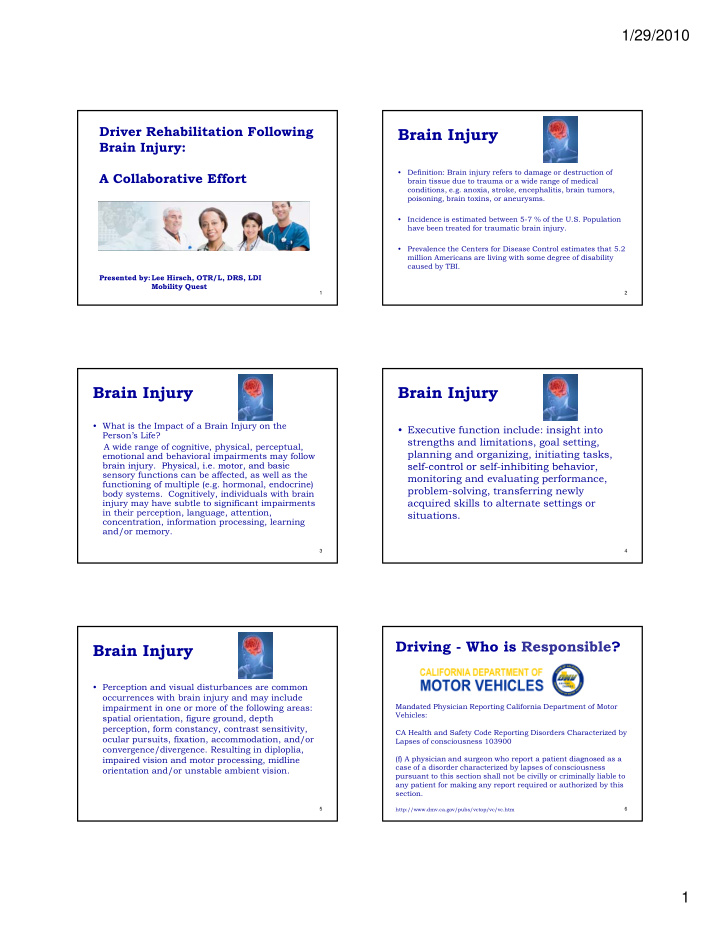



1/29/2010 Driver Rehabilitation Following Brain Injury Brain Injury: • Definition: Brain injury refers to damage or destruction of A Collaborative Effort brain tissue due to trauma or a wide range of medical conditions, e.g. anoxia, stroke, encephalitis, brain tumors, poisoning, brain toxins, or aneurysms. • Incidence is estimated between 5-7 % of the U.S. Population have been treated for traumatic brain injury. • Prevalence the Centers for Disease Control estimates that 5.2 million Americans are living with some degree of disability caused by TBI. Presented by:Lee Hirsch, OTR/L, DRS, LDI Mobility Quest 1 2 Brain Injury Brain Injury • What is the Impact of a Brain Injury on the • Executive function include: insight into Person’s Life? strengths and limitations, goal setting, A wide range of cognitive, physical, perceptual, planning and organizing, initiating tasks, emotional and behavioral impairments may follow brain injury Physical i e motor and basic brain injury. Physical, i.e. motor, and basic self control or self inhibiting behavior self-control or self-inhibiting behavior, sensory functions can be affected, as well as the monitoring and evaluating performance, functioning of multiple (e.g. hormonal, endocrine) problem-solving, transferring newly body systems. Cognitively, individuals with brain acquired skills to alternate settings or injury may have subtle to significant impairments in their perception, language, attention, situations. concentration, information processing, learning and/or memory. 3 4 Driving - Who is Responsible? Brain Injury • Perception and visual disturbances are common occurrences with brain injury and may include Mandated Physician Reporting California Department of Motor impairment in one or more of the following areas: Vehicles: spatial orientation, figure ground, depth perception, form constancy, contrast sensitivity, CA Health and Safety Code Reporting Disorders Characterized by ocular pursuits, fixation, accommodation, and/or Lapses of consciousness 103900 convergence/divergence. Resulting in diploplia, impaired vision and motor processing, midline (f) A physician and surgeon who report a patient diagnosed as a case of a disorder characterized by lapses of consciousness orientation and/or unstable ambient vision. pursuant to this section shall not be civilly or criminally liable to any patient for making any report required or authorized by this section. 5 http://www.dmv.ca.gov/pubs/vctop/vc/vc.htm 6 1
1/29/2010 STATE OF CALIFORNIA DEPARTMENT OF MOTOR VEHICLES MEDICAL CONDITIONS AND OTHER FACTORS IN DRIVER RISK Grounds Permitting Refusal of License REPORT TO THE LEGISLATURE OF THE STATE OF CALIFORNIA IN ACCORD WITH SENATE BILL 335 CHAPTER 985, 2000 LEGISLATIVE California Vehicle Code 1806 SESSION - MAY 2001 “Also discussed were various relatively common disorders, mandatorily not • The department may refuse to issue to, or renew a reportable, which have the potential to affect driving safety. The driver’s license of, any person: information presented on specific disorders comes from previously published departmental reviews of the scientific literature in this area, and from a review of (c) . . . . Who has any physical or mental disability, recently published studies identified through a search in Medline, a medical information referencing system on the Internet. disease, or disorder which could affect the safe operation of a motor vehicle unless the department operation of a motor vehicle unless the department These Orders Include: • Poorly controlled DM with • Vision disorders impairing has medical information which indicates the diabetic hypoglycemia contrast sensitivity • MI person may safely operate a motor vehicle. In • Hemianopsia • Uncontrolled Epilepsy • Trauma making it’s determination, the department may rely • CVA • Concussion on any relevant information available to the • Brain Tumor • Dizziness/Vertigo department. • Syncope • Cardiac Arrhythmias • Alcohol/Drug dependency • Sleep Apnea • Narcolepsy http://www.dmv.ca.gov/pubs/vctop/d06/vc12806.htm 7 8 Vision Requirement for Class “C” Driver’s License The CA DMV, under the Physical and Mental Disabilities Guidelines: Vision Requirement for Class “C” Driver’s License Section 5, has a “Guidelines Document” which provides matrices for visual conditions, definitions, range of severity, whether a drive test/special drive test should be administered, and types of restrictions (e.g. corrective lens, sunrise to sunset driving only, no Visual Acuity Screening– Minimum of 20/40 or better with both eyes freeway driving, area restrictions, additional mirrors (right side, wide together, and no worse than 20/70 in the poorer eye. angle, panoramic, right or left fender mounted mirrors). An immediate revocation may be imposed if an individual performs If Screening failed DMV refers to vision specialist with a form to dangerously and the condition renders the person unsafe to drive. complete the Report of Vision Examination form number DL62. complete the Report of Vision Examination form number DL62 The Vision Conditions and Actions Chart lists seven vision functions Drivers with visual acuity of 20/200 or worse may not be licensed to that may impair driving: drive. Drivers may use Bioptics for driving, but may not use them to meet the vision Standard. Central Vision Peripheral Vision (no degree of loss field is identified) Following review of the Report of Vision Examination the client may Night Vision (includes glare recovery and glare resistance) be schedule for a drive test or a special drive test to determine whether the vision condition impairs the ability to drive. Judgment of Distance Eye Movement Visual Perception 9 10 The AMA’s Opinion • It is the physician’s duty to report if: State Integrated Heath Care Team mandates reporting, or there are clear signs of • Consists of: Physicians and Optometrists, Physician impairment, or the patient is unlikely to stop Extenders: Physician Assistants, Occupational Therapists, Extenders: Physician Assistants Occupational Therapists • To Report: The physician should advise the patient Physical Therapists, Speech Pathologists, Nurse Practitioners… of their intent, they should send ONLY key information, The Clinician (physician) can • These professionals have comprehensive knowledge and skills recommend further evaluation or license that help increase access to care and reduce costs. Their revocation, Driver licensing is revoked by the teamwork is appropriate and protects the public. state NOT the physician. Per Alexander Lopez, JD, OTR, September 2007 Taken from physician presentation by G. Odenheimer, MD, K. Johnson, D.O., C. Robinson, OT, J. Walls (DPS) 11 12 2
Recommend
More recommend